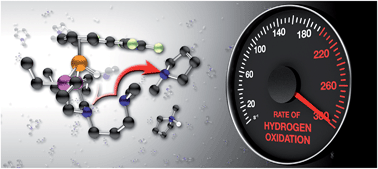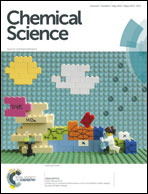Increasing the rate of hydrogen oxidation without increasing the overpotential: a bio-inspired iron molecular electrocatalyst with an outer coordination sphere proton relay†
Abstract
Oxidation of hydrogen (H2) to protons and electrons for energy production in fuel cells is currently catalyzed by platinum, but its low abundance and high cost present drawbacks to widespread adoption. Precisely controlled proton removal from the active site is critical in hydrogenase enzymes in nature that catalyze H2 oxidation using earth-abundant metals (iron and nickel). Here we report a synthetic iron complex, (CpC5F4N)Fe(PEtN(CH2)3NMe2PEt)(Cl), that serves as a precatalyst for the oxidation of H2, with turnover frequencies of 290 s−1 in fluorobenzene, under 1 atm of H2 using 1,4-diazabicyclo[2.2.2]octane (DABCO) as the exogenous base. The inclusion of a properly tuned outer coordination sphere proton relay results in a cooperative effect between the primary, secondary and outer coordination spheres for moving protons, increasing the rate of H2 oxidation without increasing the overpotential when compared with the analogous complex featuring a single pendant base. This finding emphasizes the key role of pendant amines in mimicking the functionality of the proton pathway in the hydrogenase enzymes.

- This article is part of the themed collection: Global Energy Challenges: Hydrogen Energy

 Please wait while we load your content...
Please wait while we load your content...